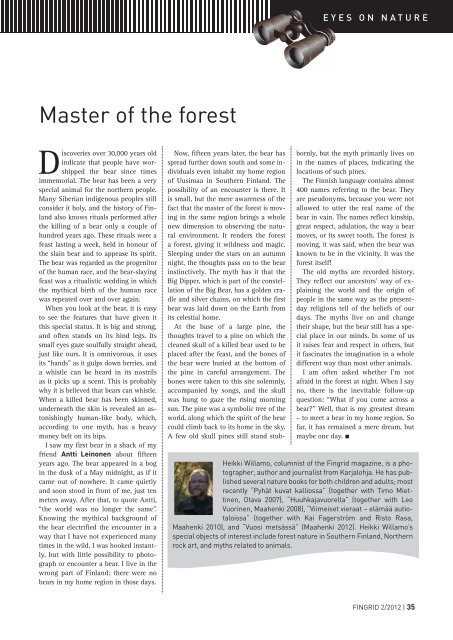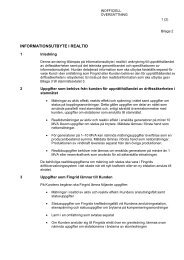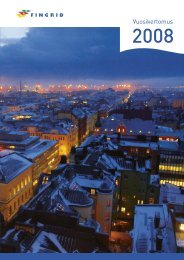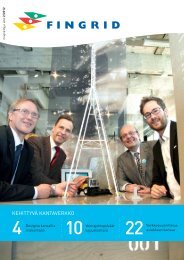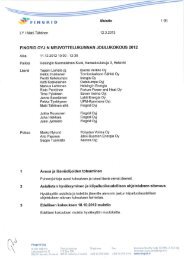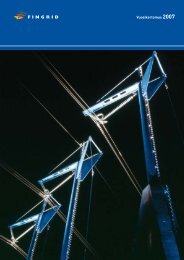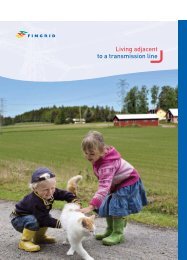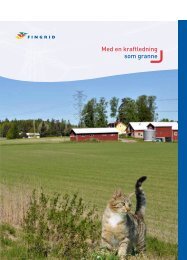2/2012 - Fingrid
2/2012 - Fingrid
2/2012 - Fingrid
You also want an ePaper? Increase the reach of your titles
YUMPU automatically turns print PDFs into web optimized ePapers that Google loves.
EYES ON NATUREMaster of the forestDiscoveries over 30,000 years oldindicate that people have worshippedthe bear since timesimmemorial. The bear has been a veryspecial animal for the northern people.Many Siberian indigenous peoples stillconsider it holy, and the history of Finlandalso knows rituals performed afterthe killing of a bear only a couple ofhundred years ago. These rituals were afeast lasting a week, held in honour ofthe slain bear and to appease its spirit.The bear was regarded as the progenitorof the human race, and the bear-slayingfeast was a ritualistic wedding in whichthe mythical birth of the human racewas repeated over and over again.When you look at the bear, it is easyto see the features that have given itthis special status. It is big and strong,and often stands on its hind legs. Itssmall eyes gaze soulfully straight ahead,just like ours. It is omnivorous, it usesits “hands” as it gulps down berries, anda whistle can be heard in its nostrilsas it picks up a scent. This is probablywhy it is believed that bears can whistle.When a killed bear has been skinned,underneath the skin is revealed an astonishinglyhuman-like body, which,according to one myth, has a heavymoney belt on its hips.I saw my first bear in a shack of myfriend Antti Leinonen about fifteenyears ago. The bear appeared in a bogin the dusk of a May midnight, as if itcame out of nowhere. It came quietlyand soon stood in front of me, just tenmeters away. After that, to quote Antti,“the world was no longer the same”.Knowing the mythical background ofthe bear electrified the encounter in away that I have not experienced manytimes in the wild. I was hooked instantly,but with little possibility to photographor encounter a bear. I live in thewrong part of Finland; there were nobears in my home region in those days.Now, fifteen years later, the bear hasspread further down south and some individualseven inhabit my home regionof Uusimaa in Southern Finland. Thepossibility of an encounter is there. Itis small, but the mere awareness of thefact that the master of the forest is movingin the same region brings a wholenew dimension to observing the naturalenvironment. It renders the foresta forest, giving it wildness and magic.Sleeping under the stars on an autumnnight, the thoughts pass on to the bearinstinctively. The myth has it that theBig Dipper, which is part of the constellationof the Big Bear, has a golden cradleand silver chains, on which the firstbear was laid down on the Earth fromits celestial home.At the base of a large pine, thethoughts travel to a pine on which thecleaned skull of a killed bear used to beplaced after the feast, and the bones ofthe bear were buried at the bottom ofthe pine in careful arrangement. Thebones were taken to this site solemnly,accompanied by songs, and the skullwas hung to gaze the rising morningsun. The pine was a symbolic tree of theworld, along which the spirit of the bearcould climb back to its home in the sky.A few old skull pines still stand stubbornly,but the myth primarily lives onin the names of places, indicating thelocations of such pines.The Finnish language contains almost400 names referring to the bear. Theyare pseudonyms, because you were notallowed to utter the real name of thebear in vain. The names reflect kinship,great respect, adulation, the way a bearmoves, or its sweet tooth. The forest ismoving, it was said, when the bear wasknown to be in the vicinity. It was theforest itself!The old myths are recorded history.They reflect our ancestors’ way of explainingthe world and the origin ofpeople in the same way as the presentdayreligions tell of the beliefs of ourdays. The myths live on and changetheir shape, but the bear still has a specialplace in our minds. In some of usit raises fear and respect in others, butit fascinates the imagination in a wholedifferent way than most other animals.I am often asked whether I’m notafraid in the forest at night. When I sayno, there is the inevitable follow-upquestion: “What if you come across abear?” Well, that is my greatest dream– to meet a bear in my home region. Sofar, it has remained a mere dream, butmaybe one day. Heikki Willamo, columnist of the <strong>Fingrid</strong> magazine, is a photographer,author and journalist from Karjalohja. He has publishedseveral nature books for both children and adults; mostrecently “Pyhät kuvat kalliossa” (together with Timo Miettinen,Otava 2007), “Huuhkajavuorella” (together with LeoVuorinen, Maahenki 2008), “Viimeiset vieraat – elämää autiotaloissa”(together with Kai Fagerström and Risto Rasa,Maahenki 2010), and “Vuosi metsässä” (Maahenki <strong>2012</strong>). Heikki Willamo’sspecial objects of interest include forest nature in Southern Finland, Northernrock art, and myths related to animals.FINGRID 2/<strong>2012</strong> | 35


